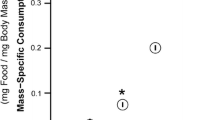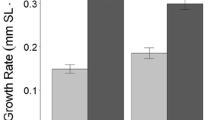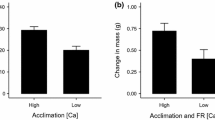Abstract
Balancing trade-offs between avoiding predators and acquiring food enables animals to maximize fitness. Quantifying their relative contribution to vital rates in nature is challenging because predator abundance and nutrient enrichment are often confounded. We employed a reciprocal transplant study design to separate these confounded effects on growth and reproduction of snails at wetland sites along a gradient of predator threats and phosphorus (P) enrichment associated with a canal. We held snails in mesh bags that allowed the passage of waterborne predator cues and fed them local or transplanted periphyton. Molluscivores were more abundant near the canal, and snails tethered near the canal suffered 33 % greater mortality than those tethered far from it (far sites). The greatest difference in snail growth rates was at the far sites where growth on far periphyton was 48 % slower than on P-enriched (near canal) periphyton. Close proximity to the canal reduced growth on near periphyton by 21 % compared to growth on the same periphyton far from the canal; there was no difference in growth rate on either periphyton type when snails were raised near the canal. Snails laid 81 % more egg masses at far sites than at near sites, regardless of periphyton origin. Top–down and bottom–up processes were elevated near the canal, and their effects canceled on growth, but not reproduction. Phenotypic trade-offs such as these may explain why some taxa show little response to nutrient enrichment, compared to others, or that the effects of nutrient enrichment may be context dependent.



Similar content being viewed by others
References
Abrams PA (1984) Foraging time optimization and interactions in food webs. Am Nat 124:80–96
Benard MF, Fordyce JA (2003) Are induced defenses costly? Consequences of predator-induced defenses in western toads, Bufo boreas. Ecology 84:68–78
Brönmark C, Lakowitz T, Nilsson PA, Ahlgren J, Lennartsdotter C, Hollander J (2012) Costs of inducible defence along a resource gradient. PLoS One 7:1–7
Browder JA, Gleason PJ, Swift DR (1994) Periphyton in the Everglades: spatial variation, environmental correlates, and ecological implications. In: Davis SM, Ogden JC (eds) Everglades: the ecosystem and its restoration. St. Lucie Press, Delray Beach, pp 379–418
Brown JS, Kotler BP (2004) Hazardous duty pay and the foraging cost of predation. Ecol Lett 7:999–1014
Chase JM (1999) To grow or to reproduce? The role of life-history plasticity in food web dynamics. Am Nat 154:571–586
Clausen J, Keck DD, Hiesey W (1940) Experimental studies on the nature of species I: effects of varied environments on western North American plants. Carnegie Institution of Washington, Baltimore
Creel S, Christianson D (2008) Relationships between direct predation and risk effects. Trends Ecol Evol 23:194–201
Cross WF, Wallce JB, Rosemond AD, Eggert SL (2006) Whole-system nutrient enrichment increases secondary production in a detritus-based ecosystem. Ecology 87:1556–1565
Crowl TA, Covich AP (1990) Predator-induced life-history shifts in a freshwater snail. Science 247:949–951
Dillon RT (2000) The ecology of freshwater molluscs. Cambridge University Press, Cambridge
Dorn NJ, Trexler JC (2007) Crayfish assemblage shifts in a large drought-prone wetland: the roles of hydrology and competition. Freshw Biol 52:2399–2411
Duever MJ, Meeder JF, Meeder LC, McCollom JM (1994) The climate of South Florida and its role in shaping the Everglades ecosystem. In: Davis SM, Ogden JC (eds) The ecosystem and its restoration. St. Lucie Press, Boca Raton, pp 225–248
Elser JJ et al (2005) Response of grazing snails to phosphorus enrichment of modern stromatolitic microbial communities. Freshw Biol 50:1826–1835
Ewe SML, Gaiser EE, Childers DL, Iwaniec D, Rivera-Monroy VH, Twilley RR (2006) Spatial and temporal patterns of aboveground net primary productivity (ANPP) along two freshwater-estuarine transects in the Florida Coastal Everglades. Hydrobiologia 569:459–474
Forrester GE, Dudley TL, Grimm NB (1999) Trophic interactions in open systems: effects of predators and nutrients on stream food chains. Limnol Oceanogr 44:1187–1197
Frost PC, Stelzer RS, Lamberti GA, Elser JJ (2002) Ecological stoichiometry of trophic interactions in the benthos: understanding the role of C:N: P ratios in lentic and lotic habitats. J North Am Benthol Soc 21:515–528
Gaiser EE, Trexler JC, Richards JH, Childers DL, Lee D, Edwards AL, Scinto LJ, Jayachandran K, Noe GB, Jones RD (2005) Cascading ecological effects of low-level phosphorus enrichment in the Florida Everglades. J Environ Qual 34:717–723
Gaiser EE, Richards JH, Trexler JC, Jones RD, Childers DL (2006) Periphyton responses to eutrophication in the Florida Everglades: cross-system patterns of structural and compositional change. Limnol Oceanogr 51:617–630
Gaiser EE, McCormick PV, Hagerthey SE (2011) Landscape patterns of periphyton in the Florida Everglades. Crit Rev Environ Sci Technol 41:92–120
Geddes P, Trexler JC (2003) Uncoupling of omnivore-mediated positive and negative effects on periphyton mats. Oecologia 136:585–595
Gérard C, Carpentier A, Paillisson JM (2008) Long-term dynamics and community structure of freshwater gastropods exposed to parasitism and other environmental stressors. Freshw Biol 53:470–484
Gilliam JF, Fraser DF (1987) Habitat selection under predation hazard: test of a model with foraging minnows. Ecology 68:1856–1862
Hereford J (2009) A quantitative survey of local adaptation and fitness trade-offs. Am Nat 173:579–588
Hoang TC, Schuler LJ, Rogevich EC, Bachman PM, Rand GM, Frakes RA (2009) Copper release, speciation, and toxicity following multiple floodings of copper enriched agriculture soils: implications in Everglades restoration. Water Air Soil Pollut 199:79–93
Hoverman JT, Auld JR, Relyea RA (2005) Putting prey back together again, integrating predator-induced behavior, morphology, and life history. Oecologia 144:481–491
Johnson PTJ, Chase JM (2004) Parasites in the food web: linking amphibian malformations and aquatic eutrophication. Ecol Lett 7:521–526
Jordan F, Coyne S, Trexler JC (1997) Sampling fishes in vegetated habitats: effects of habitat structure on sampling characteristics of the 1-m2 throw trap. Trans Am Fish Soc 126:1012–1020
Kawecki TJ, Ebert D (2004) Conceptual issues in local adaptation. Ecol Lett 7:1225–1241
McCormick PV, Shuford RBE, Rawlik PS (2004) Changes in macroinvertebrate community structure and function along a phosphorus gradient in the Florida Everglades. Hydrobiologia 529:113–132
Moran MD, Scheidler AR (2002) Effects and nutrients and predators on an old-field food chain: interactions of top-down and bottom-up processes. Oikos 98:116–124
Obaza AO, Ruehl CB (2013) Regressions for estimating gastropod biomass with multiple shell metrics. Malacologia 56:343–349
Oksanen L, Fretwell SD, Arruda J, Niemela P (1981) Exploitation ecosystems in gradients of primary productivity. Am Nat 118:240–261
Parkos JJI, Trexler JC (2014) Origins of functional connectivity in a human-modified wetland landscape. Can J Fish Aquat Sci 71:1418–1429
Peacor SD, Werner EE (2004) Context dependence of non-lethal effects of a predator on prey growth. Isr J Zool 50:139–167
Peckarsky BL, Abrams PA, Bolnick DI, Dill LM, Grabowski JH, Luttbeg B, Orrock JL, Peacor SD, Preisser EL, Schmitz OJ, Trussell GC (2008) Revisiting the classics: considering nonconsumptive effects in textbook examples of predator-prey interactions. Ecology 89:2416–2425
Peckarsky BL, McIntosh AR, Álvarez M, Moslemi JM (2013) Nutrient limitation controls the strength of behavioral trophic cascades in high elevation streams Ecosphere, vol 4, part 110
Pisani O, Scinto LJ, Munyon JW, Jaffe R (2015) The respiration of flocculent detrital organic matter (floc) is driven by phosphorus limitation and substrate quality in a subtropical wetland. Geoderma 241–242:272–278
Preisser EL, Bolnick DI, Benard MF (2005) Scared to death? The effects of intimidation and consumption in predator-prey interactions. Ecology 86:501–509
Rand GM, Schuler LJ (2009) Aquatic risk assessment of metals in sediment from South Florida canals. Soil Sediment Contam 18:155–172
Rehage JS, Trexler JC (2006) Assessing the net effect of anthropogenic disturbance on aquatic communities in wetlands: community structure relative to distance from canals. Hydrobiologia 569:359–373
Relyea RA (2001) The relationship between predation risk and antipredator responses in larval anurans. Ecology 82:541–554
Rosenzweig ML (1973) Exploitation in three trophic levels. Am Nat 107:275–294
Ruehl CB (2010) The interactive effects of predators, resources, and disturbance on freshwater snail populations from the Everglades. PhD dissertation. Florida International University, Miami
Ruehl CB, Trexler JC (2013) A suite of prey traits determine predator and nutrient enrichment effects in a tri-trophic food chain. Ecosphere 4:art75. doi:10.1890/ES13-00065.1
Sargeant BL, Gaiser EE, Trexler JC (2011) Indirect and direct controls of macroinvertebrates and small fish by abiotic factors and trophic interactions in the Florida Everglades. Freshw Biol 56:2334–2346
Sih A (1980) Optimal behavior: can foragers balance two conflicting demands. Science 210:1041–1043
Solorzano L, Sharp JH (1980) Determination of total dissolved phosphorus and particulate phosphorus in natural-waters. Limnol Oceanogr 25:754–757
Sterner RW, Elser JJ (2002) Ecological stoichiometry: the biology of elements from molecules to the biosphere. Princeton University Press, Princeton
Tibbets TM, Krist AC, Hall RO, Riley LA (2010) Phosphorus-mediated changes in life history traits of the invasive New Zealand mudsnail (Potamopyrgus antipodarum). Oecologia 163:549–559
Trexler JC, Gaiser EE, Kominoski JS, Sanchez J (2015) The role of periphyton mats in structuring consumer structure and function in calcareous wetlands: Lessons learned from the Everglades. In: Entry JA, Gottlieb AD, Jayachandrahan K, Ogram A (eds) Microbiology of the Everglades Ecosystem. CRC Press, Boca Raton, FL (in press)
Turner AM (2004) Non-lethal effects of predators on prey growth rates depend on prey density and nutrient additions. Oikos 104:561–569
Turner AM, Montgomery SL (2003) Spatial and temporal scales of predator avoidance: experiments with fish and snails. Ecology 84:616–622
Turner AM, Trexler JC, Jordan CF, Jordan SJ, Geddes P, Chick JH, Loftus WF (1999) Targeting ecosystem features for conservation: standing crops in the Florida Everglades. Conserv Biol 13:898–911
Vymazal J (1995) Algae and element cycling in wetlands. CRC Press, Boca Raton
Werner EE, Peacor SD (2003) A review of trait-mediated indirect interactions in ecological communities. Ecology 84:1083–1100
Werner EE, Peacor SD (2006) Lethal and nonlethal predator effects on an herbivore guild mediated by system productivity. Ecology 87:347–361
Wootton JT, Power ME (1993) Productivity, consumers, and the structure of a river food chain. Proc Natl Acad Sci 90:1384–1387
Acknowledgments
We thank J. Dummit, L. Harrison, L. Jiang, R. Lomax, A. Obaza, A. Parker, A. Taylor, and A. Williams, F. Tobias and P. Parker for field and lab assistance. The Everglades Foundation and the FIU graduate school provided financial support to CBR. Tom Fink at East Carolina University kindly provided access to a microscope for soft algae counts. Field data were provided by ENP-FIU Cooperative Agreement H5000060104, Task numbers J5284060023 and J5297070024 to JCT. This material was developed with help from the FCE-LTER program under NSF Grant No. DBI-0620409 and is contribution number 721 from the Southeast Environmental Research Center at FIU.
Author information
Authors and Affiliations
Corresponding author
Additional information
Communicated by Roland A. Brandl.
Rights and permissions
About this article
Cite this article
Ruehl, C.B., Trexler, J.C. Reciprocal transplant reveals trade-off of resource quality and predation risk in the field. Oecologia 179, 117–127 (2015). https://doi.org/10.1007/s00442-015-3324-4
Received:
Accepted:
Published:
Issue Date:
DOI: https://doi.org/10.1007/s00442-015-3324-4




